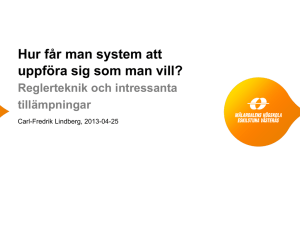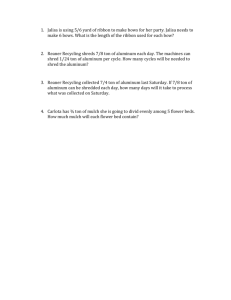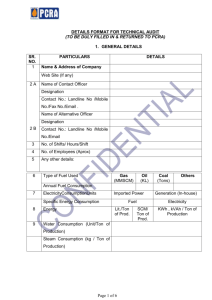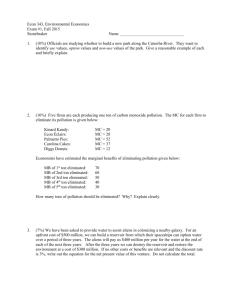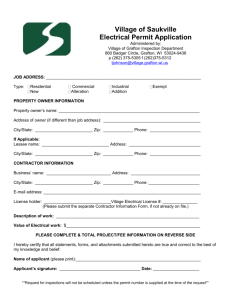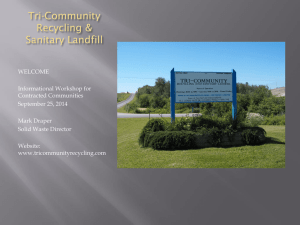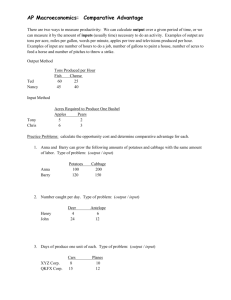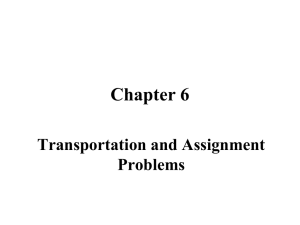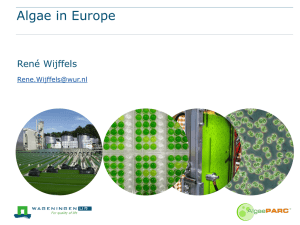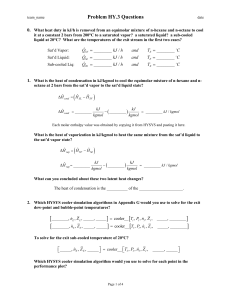ExercisesSynthesis
advertisement
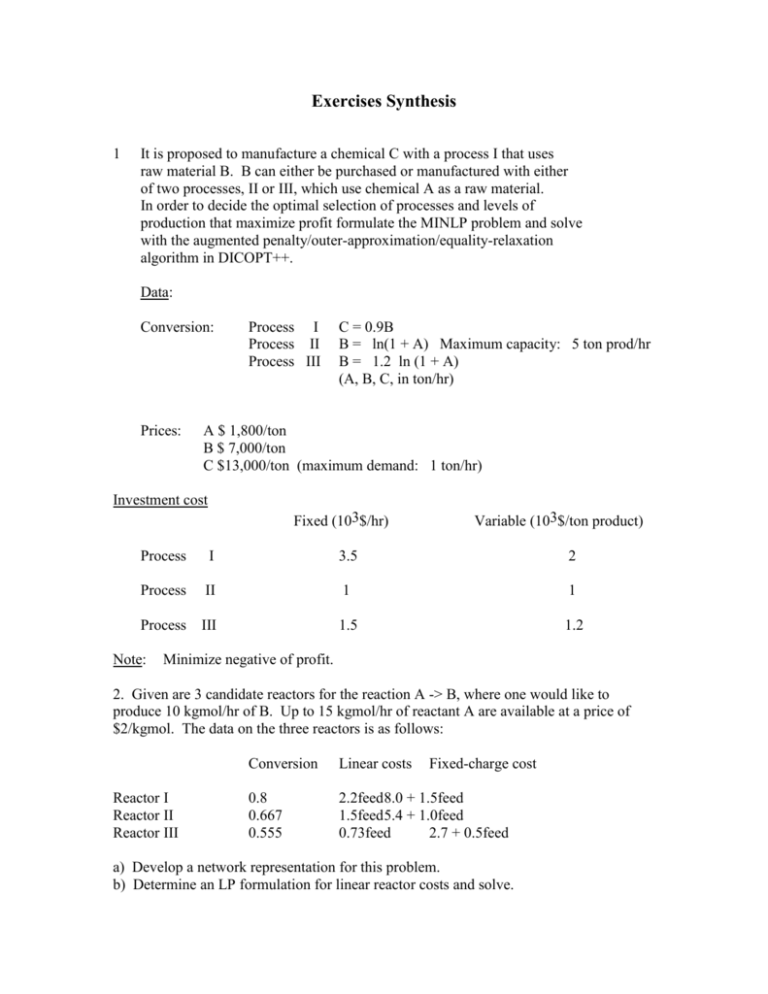
Exercises Synthesis 1 It is proposed to manufacture a chemical C with a process I that uses raw material B. B can either be purchased or manufactured with either of two processes, II or III, which use chemical A as a raw material. In order to decide the optimal selection of processes and levels of production that maximize profit formulate the MINLP problem and solve with the augmented penalty/outer-approximation/equality-relaxation algorithm in DICOPT++. Data: Conversion: Prices: Process I Process II Process III C = 0.9B B = ln(1 + A) Maximum capacity: 5 ton prod/hr B = 1.2 ln (1 + A) (A, B, C, in ton/hr) A $ 1,800/ton B $ 7,000/ton C $13,000/ton (maximum demand: 1 ton/hr) Investment cost Fixed (103$/hr) Variable (103$/ton product) Process I 3.5 2 Process II 1 1 Process III 1.5 1.2 Note: Minimize negative of profit. 2. Given are 3 candidate reactors for the reaction A -> B, where one would like to produce 10 kgmol/hr of B. Up to 15 kgmol/hr of reactant A are available at a price of $2/kgmol. The data on the three reactors is as follows: Reactor I Reactor II Reactor III Conversion Linear costs Fixed-charge cost 0.8 0.667 0.555 2.2feed 8.0 + 1.5feed 1.5feed 5.4 + 1.0feed 0.73feed 2.7 + 0.5feed a) Develop a network representation for this problem. b) Determine an LP formulation for linear reactor costs and solve. c) Determine an MILP formulation using the fixed-charge cost models and solve. d) Compare the solutions in b) and c) and explain qualitatively why differences exist in the two solutions. 3. Given is a process that involves the following hot and cold streams: Stream Fcp(KW/K) Tin(K) Tout(K) H1 H2 H3 H4 C1 C2 20 40 70 94 50 720 700 620 480 380 300 375 420 330 330 330 650 400 The following utilities are available for satisfying heating and cooling requirements: Fuel @ 750K. $150/kw HP stream @ 510K $120/kw LP stream @ 410K $ 80/kw Cooling water 300-325K $ 20/kw max. available = 6000 kW max. available = 4000 kW a) Formulate and solve the LP transshipment that will predict the minimum annual utility cost for HRAT = 10K (without and with constraints on availability of HP and LP steam). b) Indicate the loads predicted for the different utilities (in KW) and the location of pinch point(s). 4. Show that the expanded form of the LP transshipment model can be reduced to the compact LP transshipment model if there are no constraints on the heat loads of the individual matches. 5. Given the two hot and two cold streams below, determine a selection of matches that feature minimum utility consumption and fewest number of units, and which does not involve a match between hot stream H1 and cold stream C1. Formulate and solve the corresponding LP and MILP transshipment models. o Stream Fcp(KW/ C) H1 H2 C1 C2 Tin(C ) 1 2 1.5 1.3 Tout(C) 400 340 160 100 120 120 400 250 Heating utility at 500oC, Cooling utility at 30oC, HRAT = 20oC 6. Use the program SYNHEAT to synthesize a heat exchanger network for the following problem: Fcp(kW/K) Tin(K) Tout(K) H1 10 650 370 H2 20 590 370 C1 15 410 650 C2 13 350 500 Heating utility at 680K, cost = $80/kWyr Cooling utility at 300-320K, cost = $15/kWyr Individual heat transfer coefficients are 1 kW/m2K. Cost exchanger = $5000 + 150A Determine also how the following items change for setting EMAT = 1K, 5 and 15K and draw the corresponding network structures: a) Total area b) Total investment cost c) Total utility cost d) Total cost 7 Given is the four component mixture which is to be separated into pure components; A B C D 0.15 0.3 0.35 0.2 F = 1000 Kgmol/hr Assuming sharp splits with high recoveries and identical loads for condenser and reboiler, determine the optimal sequence of distillation columns with an MILP formulation. Also find the second and third best solutions. Data Fixed Variable Heat duty coefficients* System (103$/yr) (103$/hr/kgmol yr) (106kJ/kgmol) A/BCD 145 0.42 0.028 AB/CD 52 0.12 0.042 ABC/D 76 0.25 0.054 A/BC 125 0.78 0.024 AB/C 44 0.11 0.039 B/CD 38 0.14 0.040 BC/D 66 0.21 0.047 A/B 112 0.39 0.022 B/C 37 0.08 0.036 C/D 58 0.19 0.044 *Based on feed flowrate Cost of utilities: 8. CW: $20/kWyr Steam: $90/kWyr Develop a state-equipment network superstructure for the sharp separation of a mixture of 4 components (A,B,C,D). Outline the main logic constraints that apply in that problem. 9. Given are two streams, each of 40 ton/hr, containing two pollutants, A and B. Stream 1 contains 100 ppm of A and 20 ppm of B. Stream 2 contains 15 ppm of A and 200 ppm of B. It is desired to reduce the concentration of both A and B down to 10 ppm each. Assume that there are two treatment units that can be used: Unit T1 which recovers 5% of A and essentilly all of B, and unit T2 which recovers 2.4% of B and essentially all of A. a) Develop a superstructure that contains all the alternatives for mixing and splitting the two streams with the two treatment units. b) Model the problem as an NLP and solve to minimize the sum of total flow going through the units. c) Replace the NLP by an LP using the McCormick underestimators for the bilinear terms. Solve the LP and use its solution as starting point for the NLP. 4. A utility plant must supply the following demands: a) b) c) d) Power 1 = 7500 kW Power 2 = 4500 kW Medium pressure steam = 25 ton/hr (minimum) Low pressure steam = 85 ton/hr (minimum) Develop a superstructure that contains the alternatives described below. Formulate and solve as an MILP to synthesize a utility system that requires minimum annual cost. Also find the second and third best solutions. Steam: High pressure 4.83 MPa, 758 K Medium pressure 2.07 MPa, 523 K Low pressure 0.34 MPa, 412 K Steam can be raised with high pressure and/or medium pressure boilers. Let down valves can be used. Turbines: Medium to low are back pressure turbines. High pressure turbines can be expanded down to medium or to low pressure, and also have extractions to medium pressure. Power demands can be satisfied with any of these turbines, but only one turbine can be assigned to each demand. Efficiency turbines: 65% Thermodynamic data: H (high to medium) = 71 kWhr/ton H (medium to low) = 112 kWhr/ton Cost data: Fixed Boiler HP Boiler MP MP turbine HP turbine 90,000 $/yr 40,000 $/yr 25,000 $/yr 45,000 $/yr Variable 9,600 $hr/yr ton steam 8,500 $hr/yr ton steam 14.5 $/kWyr 25 $/kWyr If extraction is used in HP turbine, an additional fixed charge of 20,000 $/yr is required. NOTE: Do not consider dearator and return of steam condensate.
